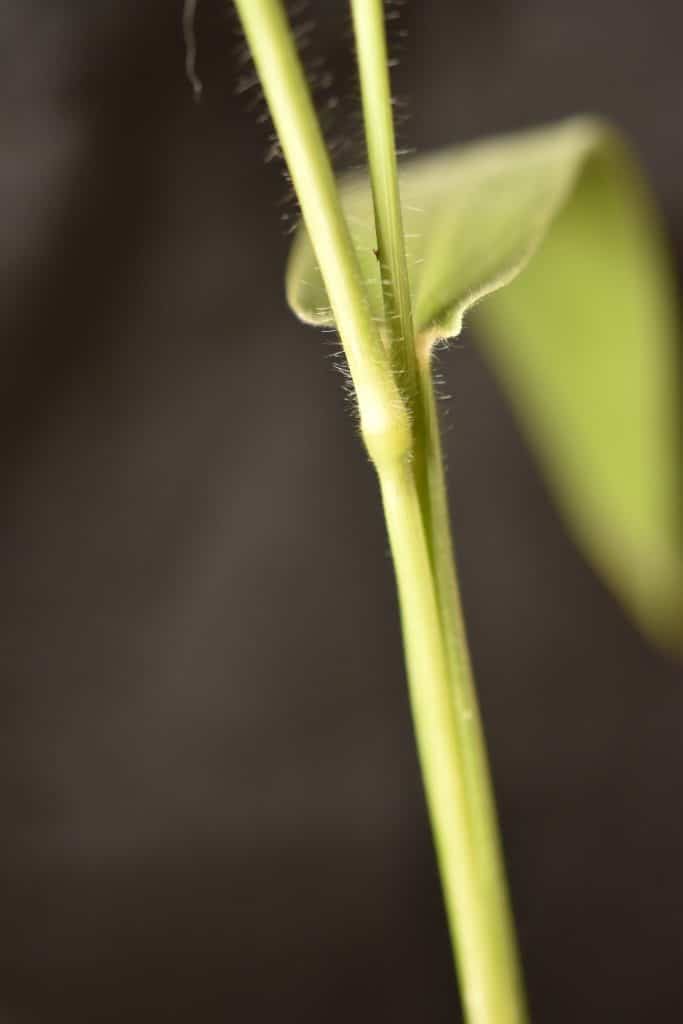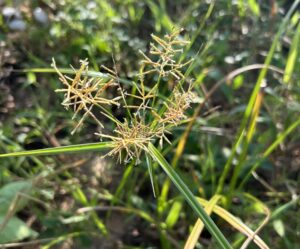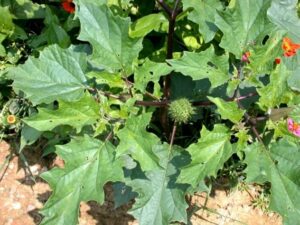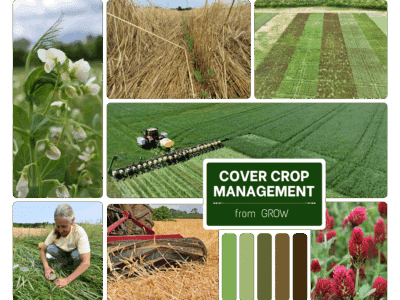Urochloa texana (Buckley) R. Webster
Also known as Texas panicum, buffalograss, Coloradograss
Note: This information is based on experience in the Mid-Atlantic states; recommendations in other regions may vary.
Texas millet, also known as as Texas panicum, is an extremely competitive summer annual grass commonly found in agronomic fields and along roadsides. Seedlings often grow close to the ground and as it gets larger it begins to grow upright and reaches heights of 2 to 3 feet. The weed has a fibrous root system and is capable of rooting at lower nodes. Texas millet seed heads are simple panicles ranging 3 to 10 inches in length and produce large seeds compared to most other summer annual grasses. The large seeds allow Texas millet to emerge from soil depths down to 3 inches. Texas millet control is challenging due to its very long germination period.
Identifying Features
Leaf sheaths and both sides of the leaf blades are covered with soft hairs. Relative to other annual grasses, the first leaves of Texas millet are broad and short. As the plant matures, leaves remain relatively wide and continue to be covered with short, soft hairs. Stems are also covered with soft hairs. Texas millet has a short membranous ligule fringed with thick hairs and lacks auricles.


Seed Production
Up to 176,500 seeds per plant were recorded when grown without crop competition.
Herbicide-Resistance
None reported.
Management
As with all weeds, prevention is key to managing Texas millet. Field equipment should be thoroughly cleaned to limit the spread of Texas millet seed into uninfested areas. Ensure manure, mulch, straw, or crop seed are free of Texas millet seed before introducing these amendments. Plants along field edges and ditchbanks must be controlled to prevent introduction into neighboring fields. Texas millet can recover following early harvest of corn and other crops; postharvest control with mowing, tillage, or herbicides is necessary to limit seed production.
Cultivation in combination with herbicides can improve control. However, cultivation should not occur within 7 days of herbicide application. Care must be taken to ensure cultivation does not lift untreated soil to the surface, thereby stimulating Texas millet seed to germinate. Texas millet will germinate throughout the summer and since most residual herbicides do not provide effective control, a postemergence application is necessary. In many situations, two postemergence applications are needed to provide full-season control.
Corn
Texas millet control by residual herbicides is fair at best and none will provide season-long control. Pyroxasulfone (Zidua or Anthem products) and isoxaflutole plus thiencarbazone (Corvus) may offer some suppression, but postemergence herbicides will almost always be necessary for full-season control. Products containing S-metolachlor (Bicep II Magnum, Dual II Magnum, etc.), acetochlor (Degree Xtra, Harness Xtra, Warrant, etc.), and dimethenamid (Outlook) do not adequately control Texas panicum. Glyphosate and nicosulfuron-containing products (Accent Q, Revulin Q, Steadfast Q) are the most effective postemergence options. Small Texas panicum (less than 2 inches tall) may be controlled or suppressed by glufosinate (Liberty), rimsulfuron (component of Realm Q, Resolve Q, and Steadfast Q), tembotrione (Laudis, component of Capreno), and topramezone (Impact, Armezon). If Texas millet seedlings emerge shortly after the postemergence application is made, a second postemergence application maybe necessary for full season control.
Sorghum
Texas millet is difficult to control in sorghum; therefore, sorghum should not be planted in heavily infested fields. Products containing S-metolachlor (Bicep II Magnum, Dual II Magnum, etc.), acetochlor (Degree Xtra, Harness Xtra, Warrant, etc.), and dimethenamid (Outlook) are weak on Texas millet. There are no satisfactory postemergence options currently available for controlling emerged Texas millet in sorghum without using herbicide-resistant hybrids. Inzen sorghum can be treated with nicosulfuron (Zest) or Double Team hybrids can be treated with quizalofop (FirstAct).
Soybean
Clomazone (Command), pendimethalin (Prowl), and trifluralin (Treflan) are the most effective residual options but do not provide full-season control. Pyroxasulfone (Zidua or Anthem products) applied preemergence offers some suppression. Similar to other crops, Texas millet control relies on postemergence options. Postemergence application of glyphosate and the graminicides are highly effective. The graminicides include clethodim (Select, Select Max), fluazifop (Fusilade), quizalofop (Assure II, Targa), and sethoxydim (Poast). Glufosinate (Liberty) will control or suppress small Texas millet (less than 4 inches).
Small Grains
Texas millet is sensitive to frost and emerges late in the spring; therefore, it is not a problem weed in winter small grains.
Perennial Forages
Pendimethalin (Prowl H2O) has a supplemental label for use in established cool-season forage grasses (forage, green chop, silage, hay, or pasture) and offers some residual control. There are no satisfactory postemergence options currently available for controlling emerged Texas panicum in grass forage or hay. Mowing may be appropriate to limit seed production. For alfalfa and other legume forages, clethodim (Select, Select Max) and sethoxydim (Poast) can be used for postemergence control. For Roundup Ready alfalfa, glyphosate effectively controls emerged Texas millet.
Fallow or Spot Treatment
Glyphosate is in order for most fallow or spot treatment situations. The graminicides, including clethodim (Select, Select Max), fluazifop (Fusilade), quizalofop (Assure II, Targa), and sethoxydim (Poast), would also be effective.
This content was presented in the “Mid-Atlantic Field Crop Weed Management Guide” (2020), Penn State Ag Communications, AGRS-136

































































































